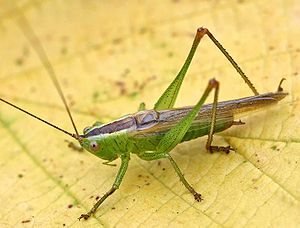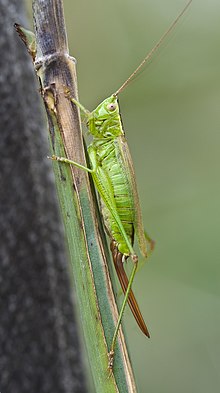Long-winged sword terrier
| Long-winged sword terrier | ||||||||||||
|---|---|---|---|---|---|---|---|---|---|---|---|---|

Long-winged sword insect |
||||||||||||
| Systematics | ||||||||||||
|
||||||||||||
| Scientific name | ||||||||||||
| Conocephalus fuscus | ||||||||||||
| ( Fabricius , 1793) |
The long-winged sword terrier ( Conocephalus fuscus , syn .: Conocephalus discolor , Xiphidium fuscum ) is a species from the subfamily of sword horrors (Conocephalinae).
features
The animals are 12 to 17 millimeters long. They have a light green body color and a brown, lightly lined back. The antennae are about three times as long as the body. The wings are very narrow and long, they protrude beyond the back knees when at rest. The females have a very long and almost straight laying tube ( ovipositor ) that is approximately the length of the abdomen. The cerci of the males are almost straight and each have an inwardly protruding tooth near the tip.
Occurrence
The species occurs in North Africa, South and Central Europe, South England, east to Asia to the Amur . In Germany, the range of this species used to extend to around the Main , in recent years it has shown an expansion to the north. In recent years there have been numerous finds of large and stable populations far north of the Main, for example in East Brandenburg, in Lower Saxony as far as the Lower Elbe and in the Hanover area and in Westphalia as far as the Ems. Today it is widespread in the north German lowlands, but avoids the low mountain ranges. In the Ruhr area, it is one of the most common types of locusts, just a short time after the first immigration.
The animals live in swampy meadows and in water on reeds and reeds . They are often found on ruderal areas , especially in the west of their area with an Atlantic climate, where their high moisture requirements are met in wet summers, even away from swamp areas. They prefer long-grass stands and are absent in short-grass and often mowed meadows. The adults appear from the end of July and can be found until October. At the same time and well into September, numerous larvae also occur.
Way of life
The animals feed on grasses and plants as well as smaller insects such as aphids and caterpillars . The females lay their narrow, whitish colored eggs individually in the leaf sheaths of sour grasses. Occasionally a hole is bite first into which the ovary is inserted. The larvae are very similar to those of the short-winged sword insect ( Conocephalus dorsalis ) and, like them, have a sharply defined, black longitudinal stripe on the back.
Organ of stridulation, song
The grasshoppers used for the measurements come from the banks of the Maisinger See, south of Starnberg, Upper Bavaria. The fore wings of the males measure 15.24 millimeters on average, the hind wings are almost as long. The mean value for the length of the active shrill ridge on the left wing is 1.51 millimeters, with an average of 38.20 shrill teeth. On the right wing, on the other hand, the receding shrill ledge measures just 1.18 millimeters and has an average of 28.77 shrill teeth. As in Conocephalus dorsalis, these represent cusps, the tips of which are flattened and covered with small teeth (picture). The mirror is better formed on the right wing than on the left. In the adult females, the fore wings are almost the same length as in the males, and there are no structures that could be used for sound production. The males' courtship song can be heard from a distance of about two meters. Over a long period of time, "zli" sounds are strung together around ten times per second.
Individual evidence
- ↑ Thomas Fartmann (2004): Hydrochory and warm years - are these the reasons for the spread of the long-winged sword insect (Conocephalus fuscus) in East Brandenburg? Articulata 19 (1): 75-80-
- ^ Günter Grein (2007): On the spread of Phaneroptera falcata (Poda, 1761) and Conocephalus fuscus (Fabricius, 1793) in Lower Saxony. Articulata 22 (1): 91-98.
- ↑ Martin Behrens, Thomas Fartmann, Norbert Hölzel (2009): Effects of climate change on biological diversity: Pilot study on the likely effects of climate change on selected animal and plant species in North Rhine-Westphalia. Part 2: second step of the sensitivity analysis - effect prognosis. Expert opinion on behalf of the Ministry for the Environment and Nature Conservation, Agriculture and Consumer Protection of the State of North Rhine-Westphalia (MUNLV NRW) download ( page no longer available , search in web archives ) Info: The link was automatically marked as defective. Please check the link according to the instructions and then remove this notice. (PDF; 11.2 MB)
- ↑ Michael Hamann & Anette Schulte (2002): Locust habitats in the industrial landscape of the Ruhr area. LÖBF-Mitteilungen 1/02: 31-35.
- ↑ a b Anna Alfonsa Stark: Investigations on the sound organ of some crickets and grasshopper species, at the same time a contribution to the right-left problem. Zoological Yearbooks, Department of Anatomy and Ontogeny of Animals 77, pp. 9–50, 1958.
- ↑ Heiko Bellmann : Der Kosmos Heuschreckenführer, Determine the types of Central Europe safely , Franckh-Kosmos Verlag-GmbH & Co KG, Stuttgart 2006, ISBN 3-440-10447-8 .
literature
- Heiko Bellmann : Der Kosmos Heuschreckenführer, The species of Central Europe safely determine , Franckh-Kosmos Verlag GmbH & Co KG, Stuttgart 2006, ISBN 3-440-10447-8 .



